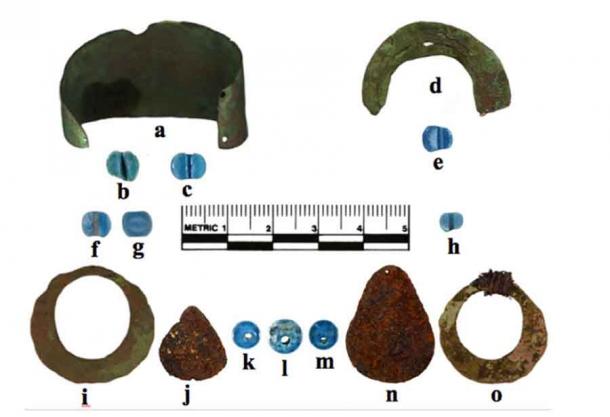The stunning discovery of pre-Columbian artifacts, originally from Europe, in Alaska could be definitive proof that ancient trade networks existed between Europe and northern Alaska in the mid-15 th century. Joining the ranks of other pre-Columbian contact theories, a bag of blueberry colored Venetian glass beads in Alaska stands as proof that European manufactured artifacts made their way to the Americas long before Christopher Columbus arrived in 1492 AD.
Oldest European Pre-Columbian Artifacts Discovered in North America
The bag of glass beads was manufactured by a Venetian jeweler before they were transported along the Silk Road , and ultimately across the Bering Strait. These pre-Columbian European artifacts were discovered in the late 20th and early 21st century at the entrance to a subterranean dwelling in northern Alaska. Now, a new paper suggests these beads represent some of “the oldest European artifacts every discovered in the Americas.”
The beads were found at three sites in the Brooks Range with is the northernmost extension of the Rocky Mountains in northern Alaska: located entirely within the Arctic Circle . The new study by Michael Kunz of the University of Alaska Museum of the North , and Robin Mills of the Bureau of Land Management , was published in the journal American Antiquity . The researchers assert that the rare glass Italian objects are among “the oldest European-made items ever discovered in North America .”

These pre-Columbian artifacts found in Alaska are the oldest European-made items ever discovered in North America. (M. L. Kunz et al. / American Antiquity )
Keeling Over at the Results
Void of organic material, stone cannot be dated. However, the scientists were able to determine the beads as “most-probably” being pre-Columbian because they discovered traces of twine from copper bangles nearby that was radiocarbon dated to between 1397 and 1488 AD. The researchers suggest in their new study that the copper jewelry and the Italian glass beads were once used as earrings or bracelets. Kunz told News NAF that when he and his research partner realized how old the beads were, they “almost fell over backwards.”
The authors note in their new paper that this discovery represents “the first documented instance of the presence of indubitable European materials in prehistoric sites in the Western Hemisphere as the result of overland transport across the Eurasian continent.”
Determining Evidence of Pre-Columbian Trade
Kunz and Mills suggest the beads were carried along the East Asian trade routes to the trading post of Shashalik and then on to the ancient Alaskan settlement Punyik Point . From here, the Italian artifacts hopped across the Arctic Ocean to the Bering Sea where, according to the researchers, somebody kayaked them across around “52 miles of open ocean.” The scientists say that the collection of beads were likely strung into a necklace and later dropped near the entrance to an underground house.”
Speaking with Gizmodo, Ben Potter , from the Arctic Studies Centre at Liaocheng University in China, said the new findings “are very cool.” Potter added that he believes the new interpretation of movement of the beads, through trade from East Asia to the Bering Strait , “makes sense.” An article in the Smithsonian says that “if confirmed” the discovery would indicate that Indigenous North Americans trading in northern Alaska wore European jewelry decades before Christopher Columbus’ 1492 AD landing in the Bahamas.

Map proposing the possible route used to transport these pre-Columbian artifacts from Venice to northern Alaska. (M. L. Kunz et al. / American Antiquity )
“Pre-Columbian Contact” – The Archaeological Panic Button
Over the last decade the traditionally hardcore skeptical scholarly response to claims of pre-Columbian European contact in the Americas has fractured. This was discussed in Alice Beck Kehoe’s 2003 paper The Fringe of American Archaeology: Transoceanic and Transcontinental Contacts in Prehistoric America . The authors said so much division has emerged in this area of research because reputable peer-reviewed papers are circulating with “circumstantial interpretations of alleged out-of-place artifacts, fringe science, pseudoarchaeology, or pseudohistory.”
Among the few pre-Columbian contact theories that are permitted to be spoken about are the 10th century Norse explorations of the New World, evident in the discovery of L’Anse aux Meadows in Newfoundland. This discovery preceded Columbus’ arrival in the Americas by more than 500 years.
The new theory of how the Italian beads got to Alaska also falls into one of the accepted schools of pre-Columbian contact thought: that there was an early “material exchange” between the peoples of Siberia and Alaska. Now it is known that this contact was made at least half a century before Columbus adventured to the New World .
Top image: Researchers have proposed a theory for why pre-Columbian artifacts, Venetian blue beads to be precise, have been discovered in Alaska. Source: M. L. Kunz et al. / American Antiquity
By Ashley Cowie
 RSS Feed
RSS Feed















 February 12th, 2021
February 12th, 2021  Awake Goy
Awake Goy  Posted in
Posted in  Tags:
Tags: 













